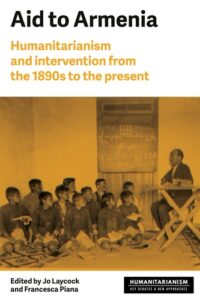
Aid to Armenia
Humanitarianism and intervention from the 1890s to the present
Publication | Table des matières | Critiques
Résumé
This is the first volume to address the history of humanitarianism and interventions on behalf of Armenia and Armenians from the 1890s to the present. It does so by examining a diverse set of actors – governments, international and diasporic organizations, and individuals that aimed at ‘saving Armenians’ in times of man-made and natural disasters. Chronologically, the volume begins with the late nineteenth century and ends with the contemporary, post-Cold War world. Geographically, the volume connects entangled spaces, extending from the Caucasus, to Russia and the Middle East, as far as Europe, North America and South America, and Australia. Aid to Armenia not only offers an innovative exploration into the history of Armenia and Armenians and the history of humanitarian interventions, but also provides a platform for contemporary practitioners to think critically about current humanitarian crises within and beyond the region.
Editors :
Jo Laycock is a Senior Lecturer in Modern History at the University of Manchester
Francesca Piana is a Visiting Lecturer at the Global Studies Institute at the University of Geneva
Table des matières
Introduction – Jo Laycock and Francesca Piana
- Humanitarian accountability: Anglo-American relief during the Hamidian massacres, 1894-98 – Stéphanie Prévost
- Pragmatism and personalities: Etienne Brasil and Brazilian engagement with Armenia, 1912-22 – Heitor Loureiro
- ‘An appeal from afar’: the challenges of compassion and the Australian humanitarian campaigns for Armenian relief, 1900-30 – Joy Damousi
- Humanitarian crisis at the Ottoman-Russian border: Russian imperial responses to Armenian refugees of war and genocide, 1914-15 – Asya Darbinyan
- ‘Making good’ in the Near East: The Smith College Relief Unit, Near East Relief, and visions of Armenian reconstruction, 1919-21 – Rebecca Jinks
- Care and connections: Orphans, refugees, and Norwegian relief in the Soviet Armenian Republi,c 1922-25 – Inger Marie Okkenhaug
- Humanitarian Diaspora? The AGBU in Soviet Armenia, 1920-30s – Vahé Tachjian
- Tremor and change: Humanitarian interventions after the 1988 earthquake in Armenia – Katja Doose
- Humanitarian intervention meets a de facto state: International peacebuilding consortiums in Nagorny Karabakh, 2003-16 – Laurence Broers
- Refuge in the ‘homeland’: The Syrians in Armenia – Sossie Kasbarian
Afterword: Displacement and the humanitarian response to suffering: reflections on aiding Armenia – Peter Gatrell
Epilogue – Ronald Grigor Suny
Critiques
- “This important volume from an authoritative international team of authors sheds significant new light on the comparative development of post-war Conservatism in the western world.”
– Stuart Ball, Professor Emeritus, University of Leicester, UK - “The rich essays collected in this illuminating volume show that the rise of right-wing politics in the United Kingdom, the United States, and France since the 1970s was a remarkably transnational phenomenon. As they attacked social democracy and cultural pluralism, right-wing movements borrowed ideas, visions, vocabularies, and tactics from each other, adapting them to their own national idioms and using advances in one country to win advances elsewhere. Anyone interested in confronting the problems that have proliferated in the wake the right’s reconfiguration of politics – surging inequality, belligerent ethno-nationalism, worker disempowerment and insecurity, and lost faith in the capacity for democratic self-government – has much to learn about the origins of these problems from this important book.”
– Joseph A. McCartin, Georgetown University, USA, author of Collision Course
